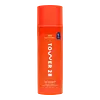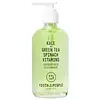What's inside
What's inside
 Key Ingredients
Key Ingredients

 Benefits
Benefits

 Concerns
Concerns

 Ingredients Side-by-side
Ingredients Side-by-side

Water
Skin ConditioningDecyl Glucoside
CleansingAloe Barbadensis Leaf Juice
Skin ConditioningNiacinamide
SmoothingCaprylyl/Capryl Glucoside
CleansingPhenoxyethanol
PreservativeGlycerin
HumectantCaprylyl Glycol
EmollientCitric Acid
BufferingChlorphenesin
AntimicrobialMagnesium Aspartate
Skin ConditioningZinc Gluconate
Skin ConditioningAlgin
MaskingAchillea Millefolium Extract
CleansingAvena Sativa Kernel Extract
AbrasiveCardiospermum Halicacabum Flower/Leaf/Vine Extract
Skin ConditioningSapindus Mukorossi Peel Extract
Skin ConditioningPanthenol
Skin ConditioningCopper Gluconate
Skin ConditioningWater, Decyl Glucoside, Aloe Barbadensis Leaf Juice, Niacinamide, Caprylyl/Capryl Glucoside, Phenoxyethanol, Glycerin, Caprylyl Glycol, Citric Acid, Chlorphenesin, Magnesium Aspartate, Zinc Gluconate, Algin, Achillea Millefolium Extract, Avena Sativa Kernel Extract, Cardiospermum Halicacabum Flower/Leaf/Vine Extract, Sapindus Mukorossi Peel Extract, Panthenol, Copper Gluconate
Water
Skin ConditioningCocamidopropyl Hydroxysultaine
CleansingSodium Cocoyl Glutamate
CleansingSorbeth-230 Tetraoleate
EmulsifyingPolysorbate 20
EmulsifyingSodium Chloride
MaskingAloe Barbadensis Leaf Juice Powder
Skin ConditioningBrassica Oleracea Acephala Leaf Extract
HumectantSpinacia Oleracea Leaf Extract
Skin ConditioningCamellia Sinensis Leaf Extract
AntimicrobialMedicago Sativa Extract
TonicChamomilla Recutita Flower Extract
MaskingTetrahexyldecyl Ascorbate
AntioxidantGlycerin
HumectantPanthenol
Skin ConditioningTocopheryl Acetate
AntioxidantDecyl Glucoside
CleansingSorbitan Laurate
EmulsifyingTetrasodium Glutamate Diacetate
Gluconolactone
Skin ConditioningEthylhexylglycerin
Skin ConditioningMaltodextrin
AbsorbentCitric Acid
BufferingPhenoxyethanol
PreservativePotassium Sorbate
PreservativeSodium Benzoate
MaskingGardenia Jasminoides Fruit Extract
Cosmetic ColorantParfum
MaskingSodium Hydroxide
BufferingSodium Glycolate
BufferingSodium Formate
BufferingHexyl Cinnamal
PerfumingLinalool
PerfumingLimonene
PerfumingCI 75810
Cosmetic ColorantWater, Cocamidopropyl Hydroxysultaine, Sodium Cocoyl Glutamate, Sorbeth-230 Tetraoleate, Polysorbate 20, Sodium Chloride, Aloe Barbadensis Leaf Juice Powder, Brassica Oleracea Acephala Leaf Extract, Spinacia Oleracea Leaf Extract, Camellia Sinensis Leaf Extract, Medicago Sativa Extract, Chamomilla Recutita Flower Extract, Tetrahexyldecyl Ascorbate, Glycerin, Panthenol, Tocopheryl Acetate, Decyl Glucoside, Sorbitan Laurate, Tetrasodium Glutamate Diacetate, Gluconolactone, Ethylhexylglycerin, Maltodextrin, Citric Acid, Phenoxyethanol, Potassium Sorbate, Sodium Benzoate, Gardenia Jasminoides Fruit Extract, Parfum, Sodium Hydroxide, Sodium Glycolate, Sodium Formate, Hexyl Cinnamal, Linalool, Limonene, CI 75810
 Reviews
Reviews

Ingredients Explained
These ingredients are found in both products.
Ingredients higher up in an ingredient list are typically present in a larger amount.
Citric Acid is an alpha hydroxy acid (AHA) naturally found in citrus fruits like oranges, lemons, and limes.
Like other AHAs, citric acid can exfoliate skin by breaking down the bonds that hold dead skin cells together. This helps reveal smoother and brighter skin underneath.
However, this exfoliating effect only happens at high concentrations (20%) which can be hard to find in cosmetic products.
Due to this, citric acid is usually included in small amounts as a pH adjuster. This helps keep products slightly more acidic and compatible with skin's natural pH.
In skincare formulas, citric acid can:
While it can provide some skin benefits, research shows lactic acid and glycolic acid are generally more effective and less irritating exfoliants.
Most citric acid used in skincare today is made by fermenting sugars (usually from molasses). This synthetic version is identical to the natural citrus form but easier to stabilize and use in formulations.
Read more about some other popular AHA's here:
Learn more about Citric AcidDecyl Glucoside is a glucose-based surfactant and emulsion stabilizer. It is created by reacting glucose with the fatty acids from plants.
Surfactants help clean the skin by trapping oil, sebum, and dirt to be washed away. As an emulsion stabilizer, it stabilizes the ingredients in a product by preventing them from separating.
This ingredient is biodegradable and non-toxic. This ingredient is commonly found in baby shampoos.
Decyl Glucoside is sometimes used to stabilize the UV filter Tinosorb.
Learn more about Decyl GlucosideGlycerin is already naturally found in your skin. It helps moisturize and protect your skin.
A study from 2016 found glycerin to be more effective as a humectant than AHAs and hyaluronic acid.
As a humectant, it helps the skin stay hydrated by pulling moisture to your skin. The low molecular weight of glycerin allows it to pull moisture into the deeper layers of your skin.
Hydrated skin improves your skin barrier; Your skin barrier helps protect against irritants and bacteria.
Glycerin has also been found to have antimicrobial and antiviral properties. Due to these properties, glycerin is often used in wound and burn treatments.
In cosmetics, glycerin is usually derived from plants such as soybean or palm. However, it can also be sourced from animals, such as tallow or animal fat.
This ingredient is organic, colorless, odorless, and non-toxic.
Glycerin is the name for this ingredient in American English. British English uses Glycerol/Glycerine.
Learn more about GlycerinPanthenol is a common ingredient that helps hydrate and soothe the skin. It is found naturally in our skin and hair.
There are two forms of panthenol: D and L.
D-panthenol is also known as dexpanthenol. Most cosmetics use dexpanthenol or a mixture of D and L-panthenol.
Panthenol is famous due to its ability to go deeper into the skin's layers. Using this ingredient has numerous pros (and no cons):
Like hyaluronic acid, panthenol is a humectant. Humectants are able to bind and hold large amounts of water to keep skin hydrated.
This ingredient works well for wound healing. It works by increasing tissue in the wound and helps close open wounds.
Once oxidized, panthenol converts to pantothenic acid. Panthothenic acid is found in all living cells.
This ingredient is also referred to as pro-vitamin B5.
Learn more about PanthenolPhenoxyethanol is a preservative that has germicide, antimicrobial, and aromatic properties. Studies show that phenoxyethanol can prevent microbial growth. By itself, it has a scent that is similar to that of a rose.
It's often used in formulations along with Caprylyl Glycol to preserve the shelf life of products.
Water. It's the most common cosmetic ingredient of all. You'll usually see it at the top of ingredient lists, meaning that it makes up the largest part of the product.
So why is it so popular? Water most often acts as a solvent - this means that it helps dissolve other ingredients into the formulation.
You'll also recognize water as that liquid we all need to stay alive. If you see this, drink a glass of water. Stay hydrated!
Learn more about Water